Chennai: Iron implements unearthed from excavations at a small hamlet called Mayiladumparai have revealed that the Iron Age in Tamil Nadu dates back 4,200 years, potentially making it the oldest in India, for now.
Previously, the Iron Age burial site of Adichanallur in southern Tamil Nadu had revealed an impressive collection of iron implements, currently housed in Chennai’s Egmore Museum, dated between 1000 BCE and 600 BCE.
Chief Minister M.K. Stalin, while addressing the Tamil Nadu Assembly Monday, said that of the 28 Accelerator Mass Spectrometry-based (AMS) dating of sites in India, this is the earliest. The 28 sites include sites in Karnataka and Uttar Pradesh.
“Through the findings, it has been established that Tamils who lived 4200 years ago were aware of iron. Dense forests were converted into fertile lands only after humankind began realising the use of iron,” Stalin said.This finding has answered questions relating to the start of agricultural activity in Tamil Nadu, he added.
Among the other important findings is evidence that the late Neolithic phase in Tamil Nadu has been identified to have begun before 2200 BCE, based on a cultural deposit of 25 cm below the dated level.
Archaeologists also found that black and red ware pottery was introduced in the late Neolithic phase itself, rather than the widely held belief that this occurred in the Iron Age.
Speaking to ThePrint, a source from the Tamil Nadu State Department of Archaeology (TNSDA) said the Mayiladumparai hamlet was the “earliest Iron Age site discovered thus far” in India.
Excavations that were carried out earlier at sites such as Malhar near Varanasi, Uttar Pradesh, and Brahmagiri in north Karnataka, had pushed the date to only around the second millennium BCE, the source noted.
“The fact that the site in Tamil Nadu dates to 4,200 years ago gives us the opportunity to better study the connections with Indus Valley Civilisation,” the source said.
Also read: An ancient people, lost to time? Mystery of giant sandstone jars found in Assam
‘Potential to study links with Indus Valley Civilisation’
The Mayiladumparai excavations were carried out at both the burial and habitation areas in the region, and revealed rock paintings and Neolithic artefacts at a depth of 104 and 130 cm, from which two charcoal samples were sent to a radiocarbon dating lab in Florida.
The site was first excavated in 2003 by Prof. K. Rajan who was then associated with the Thanjavur-based Tamil University. The TNSDA decided to resume excavations in 2021 based on his “promising results”.
“The excavation conducted in the year 2021 at Mayiladumparai in Krishnagiri district of Tamil Nadu yielded two important AMS dates that provide a clue for understanding the introduction of iron and also the transformation from the late Neolithic Phase to the Early Iron Age,” the report submitted Monday by the TNSDA revealed.
“The site met with Neolithic and Iron Age habitation mound in the terraces of the hillock called Sāṇōrappaṉmalai. The rock shelter at the top of the hill yielded habitation material with a petroglyph. The rock art with paintings both in red and white pigments was observed in the rock shelter called Niḻal-suṉai (nekul-juṉai) and the grooves used for polishing Neolithic celts were also noticed near the rock shelter,” it added.
TNSDA commissioner (in-charge) R. Sivanandam reiterated to ThePrint that the hamlet discovery was the oldest Iron Age site in Tamil Nadu, and dated about 100-200 years earlier than those in Karnataka and the Gangetic Plains.
“Across all sites in Tamil Nadu, we see proof of Indus Valley signs, graffiti, inscribed potsherds, paintings, which provides us the potential to study the connections with Indus Valley Civilisation,” he said. “We don’t see this kind of continuity and transition from graffiti, pots inscribed in Tamil-Brahmi script, to the evolution of language elsewhere.”
(Edited by Nida Fatima Siddiqui)
Also read: Fungus in 2,700-yr-old poop shows blue cheese likely dates back to Iron Age






